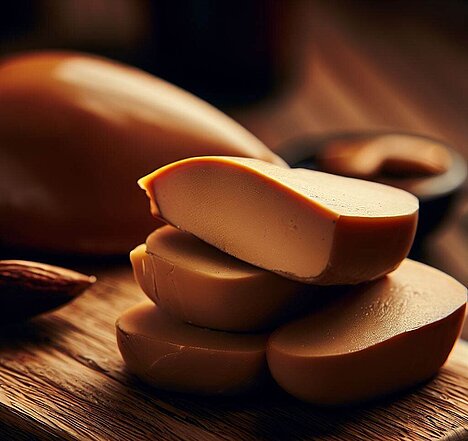Goose liver

Goose liver is a culinary specialty made from the liver of five to six-month-old geese. It is often fried or made into pâtés and is considered a delicacy in many countries. But is foie gras also suitable for dogs? In this article, you will find out what foie gras is, what advantages and disadvantages it has for dogs and how you can give it to your four-legged friend.
What is goose liver?
The goose liver is an organ that is responsible for detoxification, metabolism and blood formation. Goose livers are particularly large and rich in fat because the animals are fed a special diet before slaughter, which enlarges and fats their livers. This process, known as foie gras, is ethically controversial for animal welfare reasons and is banned in some countries.
What are the benefits of foie gras for dogs?
Foie gras is a high-quality animal protein that contains many essential amino acids. In addition, foie gras is rich in vitamins, especially vitamin A, B vitamins and vitamin K, as well as minerals such as iron, copper, zinc and selenium. These nutrients are important for the health of the skin, coat, eyes, nerves, immune system and blood clotting. Foie gras can therefore be a useful addition to a dog's diet, either raw or cooked.
What are the disadvantages of foie gras for dogs?
Foie gras also has some disadvantages that you should consider before giving it to your dog. For one thing, foie gras is very high in fat and calories, which can lead to obesity, digestive problems and pancreatitis if fed in excessive quantities or too frequently. Secondly, foie gras can contain high levels of harmful substances that accumulate in the liver, such as antibiotics, hormones or heavy metals. These can affect your dog's health if ingested over a long period of time.
How can I offer my dog foie gras?
If you want to offer your dog foie gras, you should consider a few points to minimize the risk of side effects. Firstly, you should only buy high-quality and fresh goose liver from species-appropriate husbandry. Secondly, goose liver should only be fed in small quantities and as an occasional reward or variety, not as the main food. The recommended amount is around 5 grams per kilogram of body weight per week. You can offer foie gras raw or cooked, but not fried or seasoned, as this can cause stomach irritation. You should also always provide your dog with sufficient water to aid digestion.
If you notice any signs of hypersensitivity or poisoning in your dog, you should see your vet immediately. We are not a substitute for a vet, but we try to be as accurate as possible. Every dog reacts differently and we recommend you get a second opinion or consult your vet if in doubt.
Stay healthy and take good care of your four-legged friend!😊
Similar to Goose liver
The duck liver is the organ in ducks that is responsible for detoxifying the blood. It belongs to the so-called offal that is left over when animals are slaughtered. Duck liver has a high content of...
You can feed your dog raw or cooked chicken liver. Raw has more nutrients, but also a higher risk of containing bacteria or parasites. Cooked is safer, but also less tasty. You should always wash...
Beef liver is a bovine organ that has many important metabolic functions. The liver filters the blood, stores vitamins and minerals, produces bile and helps to detoxify the body. The liver consists...
Pig liver is an organ of the pig that fulfills many important functions in the body. Among other things, the liver is responsible for detoxification, digestion, blood formation and hormone...



